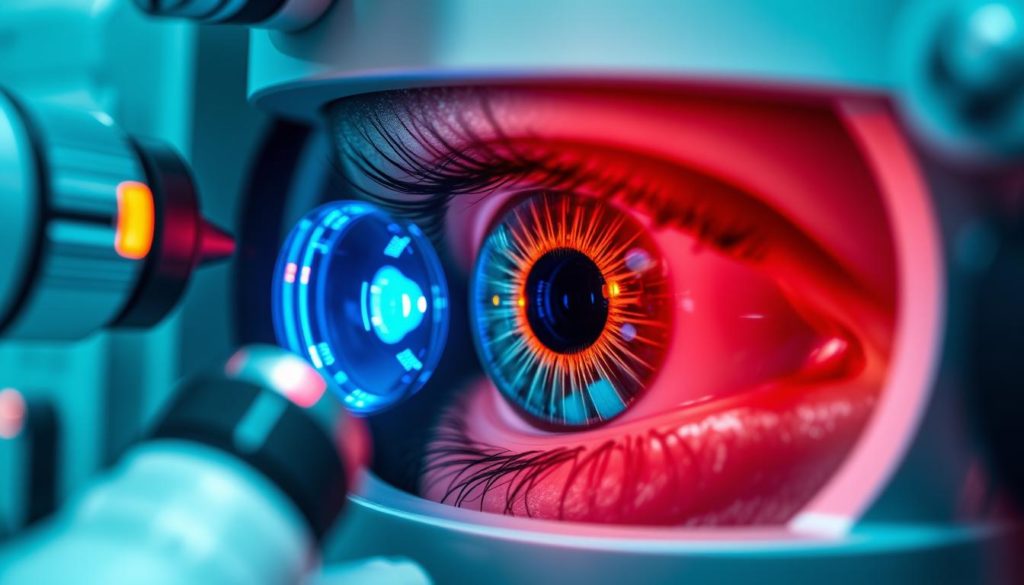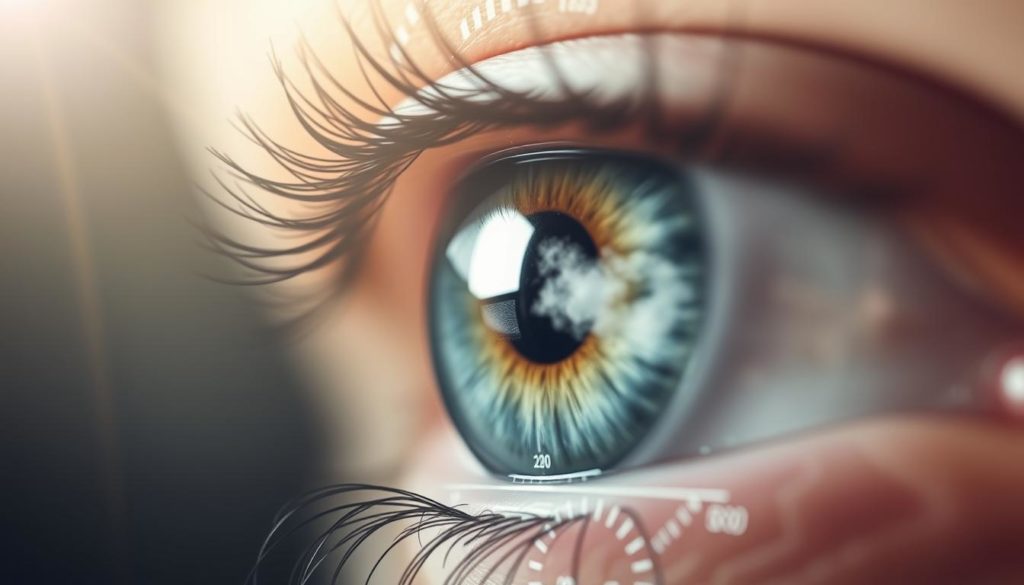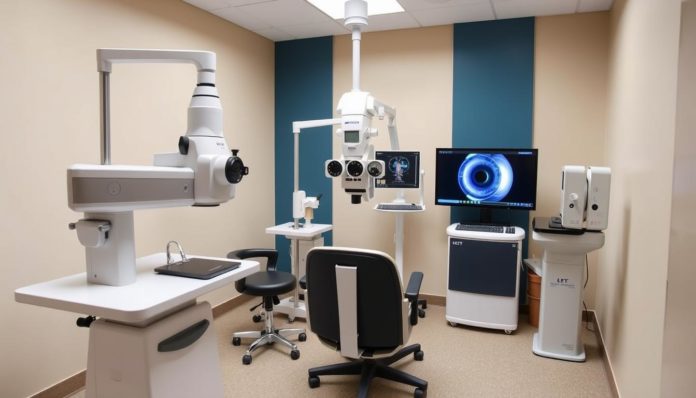“The eyes are windows to the soul and to early health issue detection,” Charles Darwin said. They tell stories about our body’s health. This shows how important it is to keep an eye on our eye health. With regular screenings, we can catch eye diseases early. This protects our most important sense.
It’s crucial to spot early signs of eye problems. Recognizing these signs early can prevent vision loss. This knowledge helps us deal with issues before they become bigger problems. This talk will cover vital signs to watch for, the role of screenings, and how to keep our eyes healthy. Let’s explore how our eyes can uncover hidden health issues. Catching these issues early is key to prevention.
The Importance of Early Detection in Eye Health
Doctors in eye care stress the need to catch eye problems early. This early catch can change a patient’s future. It helps keep sight and makes treatment easier and cheaper. Knowing the dangers of waiting too long and the benefits of quick action helps people make smart choices about their eye care.

Understanding the Risks of Late Diagnosis
Putting off checking eye issues is risky. Conditions like glaucoma, macular degeneration, and diabetic retinopathy can lead to permanent vision loss. These diseases might require more severe treatments and lower life quality. The risks of late diagnosis highlight why it’s crucial to have regular eye checks and act fast.
Benefits of Early Intervention in Eye Conditions
Doctors agree that finding eye illness early is very beneficial. Catching diseases early means treatments can be simpler and more effective. Acting early is key. It leads to better disease control, saves more of the patient’s sight, and stops the disease from getting worse.
| Condition | Risks of Late Diagnosis | Benefits of Early Detection |
|---|---|---|
| Glaucoma | Severe vision loss, possible blindness | Manageable through medication, potential vision preservation |
| Macular Degeneration | Irreversible vision loss | Slower progression, maintained quality of life |
| Diabetic Retinopathy | Complete vision impairment, blindness | Effective management of diabetes, reduced risk of vision loss |
Common Symptoms Signaling Potential Eye Problems
Finding symptoms of eye disease early can stop bigger eye issues. We’ll look at signs that might mean eye conditions are starting. These include signs found with retinal imaging, important for spotting glaucoma.
Visual Changes to Monitor
Small vision changes can be early warning signs. Look out for these symptoms:
- Blurred vision or sudden visual loss
- Floaters or tiny specks that drift through your field of vision
- Difficulty with night vision, especially while driving
These could signal deeper problems needing more tests like retinal imaging.
Physical Eye Symptoms to Be Aware Of
Physical symptoms also warn of eye health issues:
- Persistent eye redness
- Visible changes in the eye such as increased tearing or discharge
- Eye pain or discomfort
If you notice these, getting checked for conditions like glaucoma is wise.

Regular eye exams are key, especially with any symptoms mentioned. Advances in retinal imaging help catch conditions like glaucoma early.
| Visual Symptom | Possible Eye Condition | Recommended Action |
|---|---|---|
| Blurred Vision | May indicate early stages of cataract or glaucoma | Schedule a detailed eye exam |
| Floaters and specks | Can be a sign of retinal detachment | Urgent retinal imaging required |
| Difficulty with night vision | Potential early onset of retinitis pigmentosa | Genetic testing and further diagnostic imaging |
Detecting Eye Diseases Through Routine Examinations
Going for regular ophthalmology check-ups is key to keeping your eye health good and stopping diseases. A lot of eye problems, like glaucoma and diabetic retinopathy, grow silently without any clear signs. They can do a lot of harm before being noticed. Vision tests are crucial because they help find issues early. This means doctors can start treatment sooner.
In these thorough exams, eye doctors use modern tools to check how healthy your eyes are. They look at the front part of your eye with a slit lamp test, and check eye pressure with tonometry. These steps help spot glaucoma early.
| Examination Technique | Purpose | Benefits |
|---|---|---|
| Slit Lamp Examination | Examines the anterior segment of the eye | Identifies cataracts, macular degeneration, corneal injuries |
| Tonometry | Measures intraocular pressure | Early detection of glaucoma, preventing possible blindness |
| Dilation | Enlarges the pupil temporarily | Allows comprehensive assessment of the retina, crucial for detecting diabetic retinopathy |
Dilation is an important step in ophthalmology check-ups. It lets doctors see the retina better, which is key to finding disease early. Regular eye exams use cutting-edge tools. They play a huge role in keeping your eye health top-notch. They also ensure any eye problems are managed well.
Advancements in Ophthalmology for Disease Detection
The field of ophthalmology has improved a lot, especially with AI and better retinal imaging. These new technologies are changing how we find and treat eye diseases. They make eye care more proactive and tailored to each person.
Retinal Imaging Breakthroughs
Retinal imaging has made big steps forward. Techniques like optical coherence tomography (OCT) and fundus photography give clear pictures of the retina. They help find diseases like diabetic retinopathy and glaucoma early.
These improvements make diagnosing more accurate. They also help track how a disease is progressing over time.
Artificial Intelligence’s Role in Eye Care
AI is changing ophthalmology by making eye disease screenings more efficient and accurate. AI algorithms are trained with lots of data. They can spot things that humans might miss, which helps find and treat eye conditions sooner.
Thanks to these technologies, we can now catch eye problems early. We can also create treatment plans that are just right for each patient. This leads to better outcomes for people’s health.
Understanding Vision Screening and Its Limitations
Vision screening works as an early step to spot possible eye problems. Yet, it’s not as detailed as Comprehensive Eye Exams. Knowing these limits helps us fight eye diseases better.
Difference Between Screening and Comprehensive Eye Exam
Vision Screening can’t do everything a Comprehensive Eye Exam does. Screenings are quick checks, mostly done at schools or workplaces. They look for clear vision issues but can’t replace full eye exams. These exams catch smaller, yet important, health signs.
Who Should Undergo Vision Screening?
Vision screening is good for an initial look. It’s important for children to catch and treat problems like nearsightedness early. Adults with conditions like diabetes and older adults also need screenings. This is to track any big changes in their eye health.
- Children: Early detection can lead to timely interventions, preventing conditions from worsening.
- Adults with Risk Factors: Early screenings can monitor changes that might require more comprehensive examination.
- Elderly Individuals: Maintains checks on age-related eye health issues.
Adding Comprehensive Eye Exams to these screenings is key. It ensures a full check-up and helps prevent eye diseases by finding any hidden conditions.
The Role of AI in Healthcare for Ophthalmology
AI is changing how we approach eye care, with Ophthalmology Innovations at the forefront. It uses Deep Learning in Eye Disease Detection revolutionizing diagnosis and treatment. This improves patient care and makes eye doctors’ work more efficient.
Advanced systems identify complex eye diseases quickly and accurately. With this tech, spotting diseases like diabetic retinopathy and macular degeneration is easier. It’s a big step up from older methods, saving time and resources.
- Increased accuracy in diagnosing retinal diseases
- Faster processing times for screening large populations
- Reduction in healthcare costs due to early detection
Adopting digital tools in eye care also brings up issues like data privacy. But, strong security and procedures are put in place to keep patient information safe. This ensures tech progress doesn’t put patients at risk.
| Disease | Traditional Detection | AI-Enhanced Detection |
|---|---|---|
| Diabetic Retinopathy | Manual examination of retinal imagery | Automated analysis with over 90% accuracy |
| Macular Degeneration | Tests including Amsler grid and fluorescein angiography | Deep learning models detecting subtle patterns |
Deep Learning in Eye Disease Detection isn’t just a fad; it’s changing Ophthalmology Innovations for the better. As AI keeps improving, its benefits in eye care will only rise. This means more effective prevention, exact diagnoses, and tailored treatments.
Age-Related Macular Degeneration: Prevention and Early Signs
Learning about Age-Related Macular Degeneration (AMD) is key for AMD Prevention and Early Detection of AMD. Knowing how to prevent and spot the early symptoms can greatly help your eye health over time.
Spotting the Early Symptoms of AMD
Spotting early signs of Age-Related Macular Degeneration is essential for protecting your eyes. One early sign is when straight lines look wavy or bent. This is often followed by trouble seeing fine details and colors, which can make reading or recognizing faces hard.
Seeing a doctor as soon as these issues appear is very important. It can help catch AMD early and possibly slow it down.
Lifestyle Factors That Can Reduce Risk
Changing certain habits may help lower your risk of getting AMD and assist with prevention. Here are some important steps:
- Dietary Adjustments: Eating antioxidant-rich foods like leafy greens and fish with omega-3 fats supports eye health.
- Regular Exercise: Staying active helps your overall health and lowers AMD risk.
- Smoking Cessation: Not smoking is crucial because tobacco smoke greatly increases the chance of getting AMD.
Taking these steps can make a big difference in preventing AMD. It can improve your life quality and help keep your vision sharp for longer.
Computer Vision Syndrome and Modern Lifestyle
In today’s tech-centric world, many people experience Computer Vision Syndrome (CVS). This condition is linked to the strain on our eyes from long screen use. Symptoms include headaches, sore, dry eyes, and blurry vision. It’s key to focus on our Digital Eye Health due to our heavy tech use.
Experts recommend strategies to lessen screen time’s negative effects. The 20-20-20 rule is helpful – after 20 minutes of screen time, look at something 20 feet away for 20 seconds. This helps rest your eyes. Also, using the right lighting and ergonomic furniture helps avoid CVS. These adjustments keep your eyes from getting strained.
With digital devices being a big part of our lives, knowing when to take a break is important for eye health. Make sure to use screen filters, go for regular eye checks, and do eye exercises. Acting early against Computer Vision Syndrome keeps our vision sharp for tomorrow’s digital challenges.
FAQ
What are the earliest signs of potential eye diseases?
Early signs include blurred vision, sensitivity to light, and trouble seeing at night. You might also see floaters or changes in your vision field. It’s key to see an ophthalmologist if you notice these signs.
Why is early detection of eye diseases so important?
Early detection boosts the success of treating eye diseases. It also helps prevent serious issues like vision loss. Early treatments can slow or stop disease progression.
What are some visual changes that could indicate an eye problem?
Sudden vision loss, distorted vision, double vision, or seeing halos are key warning signs. These changes mean you should get a professional check quickly.
What physical eye symptoms should prompt a visit to the eye doctor?
Red eyes, ongoing eye pain, swelling, and noticeable changes in the eye like lumps mean you should see a doctor soon. Irregular pupils are also a sign.
What can I expect during a routine eye examination?
Routine eye exams review your eye health history and include various tests. They look for glasses or contact lens needs and check for diseases. Exams often have dilation for a detailed retinal exam, and tests for glaucoma.
How have advancements in retinal imaging improved eye disease detection?
New retinal imaging tech gives detailed retina views. OCT and fundus photography catch diseases early. Often, they find issues before patients notice symptoms.
What is the difference between vision screening and a comprehensive eye exam?
Vision screening is basic, spotting potential vision issues. A comprehensive eye exam is deeper, diagnosing conditions that screenings might miss.
Who should undergo vision screening?
Children need screenings to find problems that could affect learning. Adults at risk for eye diseases and the elderly should also be screened to catch age-related conditions.
What role does artificial intelligence play in the field of ophthalmology?
AI is key in ophthalmology. It uses deep learning to accurately diagnose conditions like diabetic retinopathy. This improves disease detection’s speed and accuracy.
Can lifestyle factors reduce the risk of age-related macular degeneration (AMD)?
Yes. Reducing AMD risk can come from a healthy diet full of greens and fish, regular exercise, and not smoking.
What is Computer Vision Syndrome and how is it related to modern lifestyle?
Computer Vision Syndrome, or Digital Eye Strain, includes eye problems from long screen use. More screen time in today’s lifestyle is a big cause.
How can I protect my eyes while using computers and other digital devices?
Protect your eyes by following the 20-20-20 rule: every 20 minutes, look 20 feet away for 20 seconds. Have good lighting and keep screens at eye level. Taking breaks from screens helps too.


